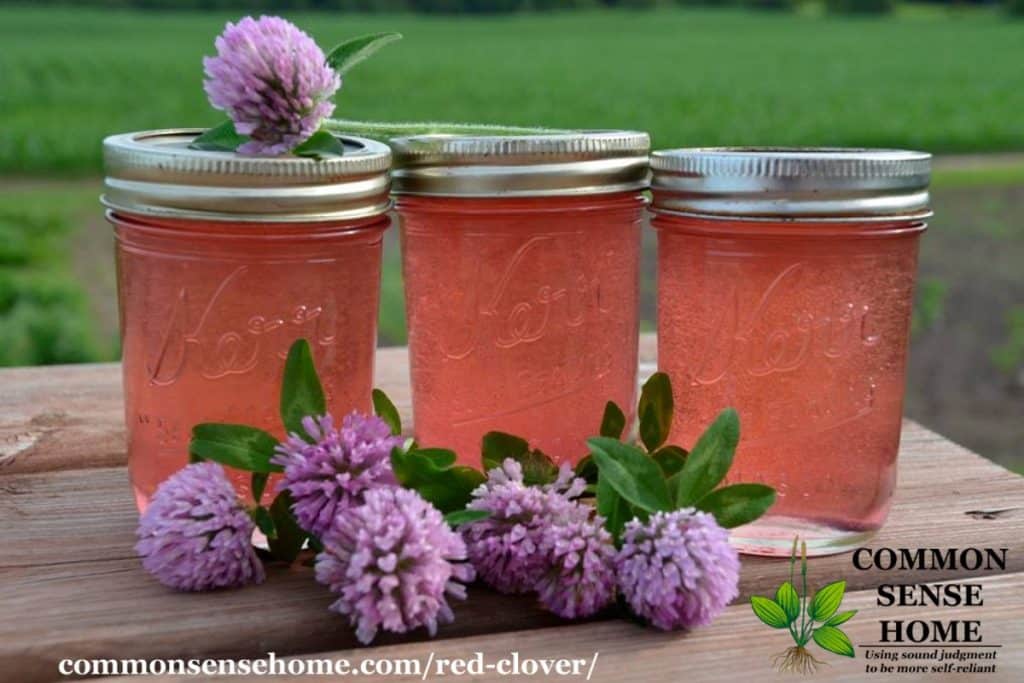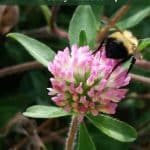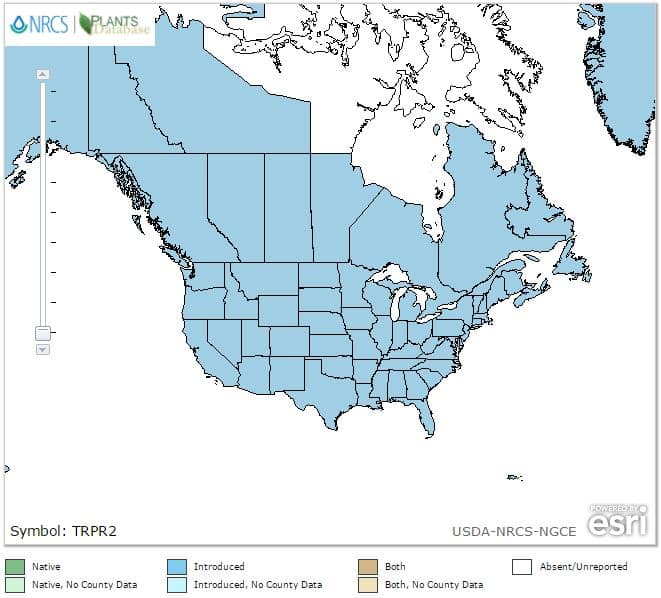Red Clover – Nitrogen Fixer and Gentle Tonic – Weekly Weeder #4
Welcome to the Weekly Weeder series. This week's weed is Red clover, Trifolium pratense. (Trifolium means “three leaves”.) Native to Europe, red clover was introduced to North America as a fodder crop. It has now naturalized throughout the Americas, Australia and many other parts of the world. Red clover is a legume, and adds nitrogen to the soil, enriching it for other crops.

Range and Identification of Red Clover
Where does red clover grow?
Red clover is still cultivated in many areas, but it can also found in old fields, pastures, roadsides and in gardens. It prefers full sun and tolerates a range of moisture levels and soil types. It is a perennial, so it comes back year after year. Like most weeds, seeds can stay dormant for many years before sprouting.
Source: USDA Natural Resources Conservation Service
Red Clover Identification
Red clover plants are 6-24″ tall and spread into a leafy clump of foliage. Leaves are 3 lobed, like the rest of the clover family, 1/2-2″ wide. Each leaf is marked by a white chevron in the shape of a “V”. Leaves are attached in an alternating pattern up the stem. Flowers are formed at or near the top of the stem. Each “clover blossom” is a composite of many (50-100) small tubular flowers. The flower clusters are roughly 1″ across and pink-purple in color.

Wildlife Uses of Red Clover
Our clover is always visited by bees and butterflies, and the wild rabbits and deer enjoy it as a snack. Heck, almost everything enjoys red clover. Illinois Wildflowers gives an excellent summary many of the critters that enjoy a clover feast:
The nectar and pollen of the flowers attract many kinds of long-tongued bees, including bumblebees, Anthophorine bees, mason bees, and large leaf-cutting bees (Megachilini tribe). Butterflies, skippers, and day-flying Sphinx moths also visit the flowers for nectar. Typical visitors among the butterflies include Swallowtails, Monarchs, Painted Ladies, Whites, and Sulfurs. The caterpillars of several butterflies feed on the foliage, including Everes comyntas (Eastern Tailed-Blue), Colias eurytheme (Orange Sulfur), Colias philodice (Clouded Sulfur), and Colias cesonia (Dog-Faced Sulfur). The caterpillars of many moth species feed on the foliage of this and other Trifolium spp. as well (see Moth Table).
Both the seedheads and foliage are eaten occasionally by upland gamebirds, including the Ruffed Grouse, Greater Prairie Chicken, Wild Turkey, and Ring-Necked Pheasant. Similarly, many small mammals eat the seedheads and/or foliage, including the Cottontail Rabbit, Groundhog, Thirteen-Lined Ground Squirrel, and Meadow Vole. Among the hoofed browsers, the foliage of Red Clover is readily eaten by deer, horses, cattle, and sheep. The value of Red Clover to wildlife and domestic animals is high.
Red Clover as Food
Eat young leaves and blossoms fresh in salad. One of my favorite summer garden nibbles is fresh blossoms. Simply pick a flower, pull out a cluster of the tiny flowers, and suck the nectar out of the base. It's a tiny treat, but sweet and delicious.
The blossoms are also used to make clover jelly, teas, mead, syrup and other edible flower fare.

Red Clover Jelly
Delicate red clover jelly recipe made with fresh clover blossoms.
Ingredients
- 2 cups packed clover blossoms, no leaves, no stems
- 2 1/2 cups boiling water
- 1/4 cup lemon juice – fresh is great if you have it
- 4 cups sugar
- One box Sure-jell powdered pectin
Instructions
First, infuse the blossoms in the water. Place the blossoms in a heat resistant container and pour the boiling water over. Allow them to steep 8 hours or overnight.
When ready to can, sterilize four 8-ounce jars or eight 4 ounce jars, keep hot. Heat lids and rings in hot water, keep warm but not boiling. Fill water bath canner and bring to boil.
Strain the flowers out of the water. Squeeze dry. You should have 2 1/4 cup infused water. Add more water if needed. I allowed the strained liquid to sit in the refrigerator overnight, and then poured it off carefully. This allowed some of the particles to settle out of the infusion, resulting in a clearer jelly.
Place the flower infusion, lemon juice and pectin in a large heavy bottom pot. Bring to a rolling boil. Add sugar all at once, return to boil. Boil for one minute, stirring constantly. Skim foam if needed. Remove from heat.
Ladle jam into sterilized jars leaving 1/4″ headspace. Wipe rims clean and screw on the lids. Process for 10 minutes in water bath canner (add 1 minute for every 1,000 feet above sea level). Remove jars from canner and allow to rest until cool (I prefer overnight) before removing rings, wiping any drips and labeling for storage.
Makes around 4 half pint jars or 8 – 4 ounce jars.
Red Clover as Medicine
Like many “weeds”, clover has medicinal properties and very few side effects. The University of Maryland Medical Center gives an overview of clover's medicinal properties:
Medicinal Uses and Indications:
Red clover is a source of many nutrients including calcium, chromium, magnesium, niacin, phosphorus, potassium, thiamine, and vitamin C. Red clover is a rich sources of isoflavones (chemicals that act like estrogens and are found in many plants).Treatment
Cardiovascular healthResearchers theorize that red clover might help protect against heart disease, but studies in humans have not found strong evidence. Red clover isoflavones have been associated with an increase in “good” HDL cholesterol in pre- and postmenopausal women, but other studies show conflicting evidence. One study found that menopausal women taking red clover supplements had more flexible and stronger arteries (called arterial compliance), which can help prevent heart disease. Red clover may also have blood-thinning properties, which keeps blood clots from forming. It appears to improve blood flow.MenopauseResearchers also think that isoflavones, like those found in red clover, might help reduce symptoms of menopause because of their estrogen-like effects. But so far studies have not been conclusive. Several studies of a proprietary extract of red clover isoflavones suggest that it may significantly reduce hot flashes in menopausal women. The largest study, however, showed no such effect.OsteoporosisAs estrogen levels drop during menopause, a woman's risk for developing osteoporosis (significant bone loss) goes up. A few studies suggest that a proprietary extract of red clover isoflavones may slow bone loss and even boost bone mineral density in pre- and perimenopausal women. But the evidence is preliminary, and more research is needed to say for sure.CancerBased on its traditional use for cancer, researchers have begun to study isoflavones from red clover. There is some preliminary evidence that they may stop cancer cells from growing or kill cancer cells in test tubes. It's been proposed that red clover may help prevent some forms of cancer, such as prostate and endometrial cancer. But because of the herb's estrogen-like effects, it might also contribute to the growth of some cancers, just as estrogen does. Until further research is done, red clover cannot be recommended to prevent cancer. Women with a history of breast cancer should not take red clover.Other usesTraditionally, red clover ointments have been applied to the skin to treat psoriasis, eczema, and other rashes. Red clover also has a history of use as a cough remedy for children.Dosage and Administration:
Red clover is available in a variety of preparations, including teas, tinctures, tablets, capsules, liquid extract, and extracts standardized to specific isoflavone contents. It can also be prepared as an ointment for topical (skin) application.Pediatric
Red clover has been used traditionally as a short-term cough remedy for children. Products containing isolated red clover isoflavones are very different than the whole herb, however, and are not recommended for children. Do not give a child red clover without talking to your pediatrician first.Adult
Dose may vary from person to person, but general guidelines are as follows:
- Dried herb (used for tea): 1 – 2 tsp dried flowers or flowering tops steeped in 8 oz. hot water for 1/2 hour; drink 2 – 3 cups daily
- Powdered herb (available in capsules): 40 – 160 mg per day, or 28 – 85 mg of red clover isoflavones
- Tincture (1:5, 30% alcohol): 60 – 100 drops (3 – 5 mL) three times per day; may add to hot water as a tea
- Fluid Extract (1:1): 1 mL three times per day; may add to hot water as a tea
- Standardized red clover isoflavone extracts: directions on product labels should be carefully followed
- Topical treatment (such as for psoriasis or eczema): an infusion, liquid extract, or ointment containing 10 – 15% flowerheads; apply as needed unless irritation develops. Do not apply to an open wound without a doctor's supervision.
Although some red clover isoflavones are being studied for a variety of conditions, it is important to remember that extracts of red clover isoflavones are very different from the whole herb. In fact, they represent only a small, highly concentrated part of the entire herb.Precautions:
Side Effects
No serious side effects from red clover have been reported in people taking red clover for up to one year. General side effects can include headache, nausea, and rash. However, animals that graze on large amounts of red clover have become infertile.Pregnancy and Breastfeeding
Pregnant or breastfeeding women should not take red clover.Interactions and Depletions:
Red clover may interfere with the body's ability to process some drugs that are broken down by liver enzymes. For that reason, you should check with your doctor before taking red clover.Estrogens, hormone replacement therapy, birth control pills — Red clover may increase the effects of estrogen.Tamoxifen — Red clover may interfere with tamoxifen.Anticoagulants (blood thinners) — Red clover may enhance the effect of these drugs, increasing the risk of bleeding. The same is true of herbs and supplements that have blood-thinning effects (such as ginkgo, ginger, garlic, and vitamin E).
I keep a stock of dried clover blossoms and other homegrown/wildcrafted medicinal herbs in my pantry for regular use.
Note: All material in this post is for informational purposes only and is not meant to take the place of a trained healthcare provider.
Recommended Resources:
- The Forager's Harvest
- The Wild Wisdom of Weeds
- Wildflowers Of Wisconsin
- Weeds, Control Without Poisons
- The Edible Wild
You may also find useful:
- Recommended Wildcrafting Reference Books – Weekly Weeder #1
- Chickweed – Weekly Weeder #2
- Thistle – Weekly Weeder #3

Originally published in 2011, updated in 2017.




I followed this recipe to a T! More than once. And they never jelled. I have jars full of liquid. *sigh* what am I missing here? Is something in this recipe off?
I’ve made it successfully, as have others, so I don’t believe there are any typos.
Things to check:
Is the sure-gel pectin out of date?
Did you boil it enough?
Did you use the full amount of sugar?
How’s the water that was used for infusing the flowers? I’ve never run into a problem using RO water, but there’s a remote possibility that something in municipal or well water may interfere with gelling.
By the time you take the jelly off the heat, you should be able to dip in a refrigerated spoon and have the jelly start to gel on the spoon. If it’s not gelling on that cool spoon (mimicking the thickening that will happen as the jelly cools), it needs to cook more.
This looked and sounded so good I wanted to go find some red clover and get it planted… until I read the side effects. We are a blood thinner house. Thank you for including that info. People who do not use their kitchens and use knives and plunge into projects don’t understand how a whole house comes to a halt with the words I cut myself! Then we spent the next half hour to hour stopping the bleeding on something that most people would ignore or maybe put a bandaid on.
Blood thinners add a whole new element to being cautious. I’ve had a couple loved ones on them over the years. Between the bleeding and bruising, you definitely need to be careful. I’m glad you ended up here and avoided extra potential trouble.
we were always told that a dirty child is a healthy child. I had 7 kids in 8 years in a rural area and they spent most of their time outside. My grandkids spend too much time in front of the tv or gaming and have all the signs of it. Someone sick all the time. I am studying herbalism at the min and getting them out with me looking for weeds. 11 out of the 12 walking and baby in her buggy. Looks like a fun summer ahead. God bless and happy weeding
They are lucky to have you in their lives. Get ’em dirty, grandma!
Hi Laurie, I have just subscribed to you wonderful site. Firstly let me assure you, you are not the only weedy out there. I live in Ireland and love weeds. A quick story on red clover: When my son was little he was always eating clover flowers, he couldn’t get enough. Just after his second birthday we discovered he had a Wilms tumour on his left kidney. A neighbours little boy had the same. ( I blame chemical herbicide being sprayed near us while we were pregnant). When he went for surgery the tumour was inside a bubble and had not spread. Despite loosing his kidney he made a great recovery. Unfortunately his little friend didn’t.
Years later I discovered the clover flowers have been well known to contain tumours and stop them from spreading. I truly believe they saved his life. He is now all grown up with two beautiful children.
Just my pennys worth .
Thank you so much for sharing your son’s story, Marian. I’m so thankful that you allowed him to eat the plants he needed to protect himself. Many are so germ-phobic nowadays that the idea of eating anything wild scares the pants off of them.
This is a very delicious jelly, other than way too much sugar in my opinion. I cut the sugar to about 1.5 cups and it was still almost too sweet, and still set up nicely.
The sugar ratio is typical for a Sure-jel recipe. (They tend to be quite sweet.) If you’d like to drop the sugar even lower, I’d suggest switching to a low-sugar/no sugar pectin, such as Pomona’s Universal Pectin.
I was told deer don’t like red clover, that’s why some road/highway depts plant it along the road sides.
That hasn’t been my experience, and other sources also suggest its use in food plots for deer, such as the article from Quality Deer Management “Food Plot Species Profile: Red Clover”:
I think it’s planted along roadsides because it adapts well to different soils and dry conditions.
Thank you for the jelly recipe. I will try it. I have loads in my food Forrest garden.
You’re welcome.
Can dried blossoms be used for the jelly or only fresh ones?
I don’t think the flavor will be as strong, but it you can certainly try it out and see if you like it, since it’s a small batch jelly.
Thank you for this information, Laurie! It amazes me every time I learn of yet another “weed” that is so good for us!
I’m wondering if the jelly would work with stevia instead of sugar, or does it need the sugar to set up/thicken?
You can’t use stevia with conventional pectin, but odds are it would work with Pomona’s pectin, which is specifically formulated for recipes with low or no sugar.
You’re welcome. I’ve come to look at most of my “weeds” as old friends at this point.
Thank you. I'm glad you enjoy them.
I love reading about "weeds" and find your posts very interesting!
Can you give us a recipe on how to make tea from the glover blossoms? Maybe you did and I need to reread over this page. Thanks, Betty
Under Adult dose: Dried herb (used for tea): 1 – 2 tsp dried flowers or flowering tops steeped in 8 oz. hot water for 1/2 hour; drink 2 – 3 cups daily
Alternatively, you can also use fresh blossoms. Fill your cup half full of fresh blossoms, fill with hot water, cover and steep for 10-15 minutes. Strain and enjoy.
Anna – I'm glad you found me, too.
Thanks to both of you for commenting. I wonder sometimes if people are interested, or if I'm the only "weed person" around. 🙂
I'm really enjoying your weekly weeder posts. So far each plant has been a resident of my backyard too. 🙂 Good info and an easy read. Thanks!
This was such a lovely post to read as I love clover and am always sorry to hear it dismissed as a weed. How wonderful to know it has all these uses and properties. So glad I stumbled on your blog!